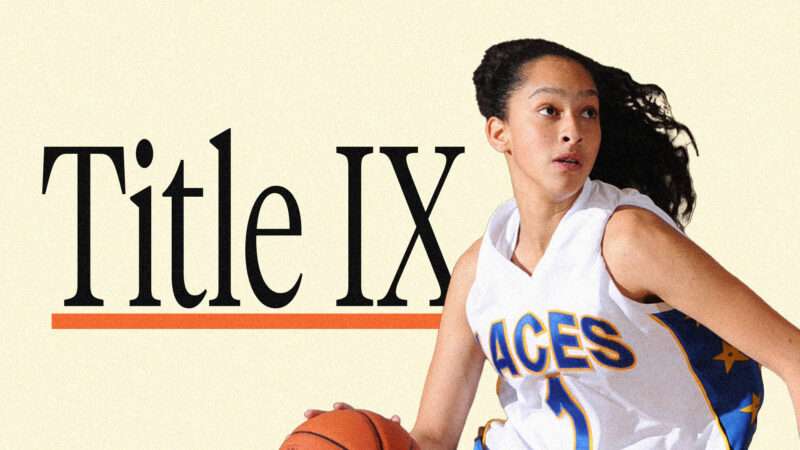
Passed 50 years ago, to the day, Title IX was not created in order to give women more athletic opportunities—that was just a byproduct. In fact, "the [law's] initial supporters were just as surprised as the athletic departments when it became clear that this law would also apply to sports programs," according to feminist historian Susan Ware in comments to Sports Illustrated.
Title IX starts with:
"No person in the United States shall, on the basis of sex, be excluded from participation in, be denied the benefits of, or be subjected to discrimination under any education program or activity receiving federal financial assistance."
The words sports, athletics, or even physical education never appear in the law since the original intent of the legislation was to alleviate imbalances between men and women in education.
Title IX initially meant educational institutions had to provide both sexes with opportunities "substantially proportionate to their respective enrollments." And a 1992 court decision determined that noncompliant schools could face lawsuits, as well as being cut off from federal funding.
But when implemented, Title IX effectively turned into a form of affirmative action for women in sports—an unsustainable quota-like system. It's proven difficult for schools to equally allocate resources—scholarships, equipment, arenas, and budgets—across genders and sports, which has caused schools to take the easy way out by slashing male programs. Especially given that football, a huge moneymaker on college campuses, doesn't have a female equivalent in size or impact.
In 1970, just 44 percent of women in the U.S. graduated from high school, and only 11 percent had college degrees. Today, about 91 percent of American women complete high school, with over 39 percent going on to earn degrees from colleges and universities. In 1972, only 294,015 women competed on high school sports teams. By the 2018-2019 academic year, 3.4 million women competed on high school sports teams. In the early '70s, some 30,000 women competed on college sports teams. By 2020, that number had risen to 215,486.
Title IX did remove barriers for women and girls to participate in sports, but the implementation has been flawed, with worse outcomes than anticipated. "Things have gone from absolutely horrendous to only very bad," Bernice R. Sandler, director of the Association of American Colleges' Project on the Status and Education of Women, told The Washington Post, a full decade after Title IX was passed. Full equality has yet to be achieved—and in some areas, probably can't be achieved, given the lack of equivalent women's teams for football and basketball, for example—and this legislation continues to put colleges and universities in a bind to reach unachievable quotas.
There's nothing in Title IX that requires schools to cut or reduce men's opportunities in order to be compliant. But men's teams haven't gone unscathed in the last five decades. Title IX presented a complicated numbers game to athletic departments: Their student-athletes had to reflect the same gender disparity as that of the school plastered on their uniforms. So if a college campus was 56 percent women, then roughly 56 percent of the student-athletes should also be women. Is this even achievable when the two most profitable sports—football and basketball, which consume roughly 80 percent of men's sports budgets—require male athletes?
It should come as no surprise that college football takes up a majority of the scholarships awarded to male athletes nationally—roughly 26,000, or 22,500 more scholarships than women's swimming and diving (the sport I competed in at a collegiate level) offers. The odds of getting a women's swimming and diving scholarship when I graduated high school were 47 to one. By comparison, football players had 43 to one odds of going on to play in the National Collegiate Athletic Association (NCAA) after high school. It's nearly impossible to make scholarship opportunities equally accessible for both sexes for every sport at every school.
Back in 2002, George Will called Title IX a "policy train wreck" because of how it has negatively impacted male sports. "Colleges have killed more than 400 men's athletic teams in order to produce precise proportionality between men's and women's enrollments and men's and women's rates of participation in athletics," wrote Will. And what Michael Lynch wrote for Reason circa 2001 still rings true today: "The tragedy of Title IX is that virtually nobody is pleased with its current results."
It's only gotten worse since the pandemic hit. Many colleges faced major budget deficits from a year without March Madness, and are still reeling from the earnings loss that came with fanless football games. For many schools, cutting programs was inevitable. Title IX was at the forefront of many athletic directors' minds on the cutting room floor, but their hands were tied, and budgets constrained, due to the requirements of the law.
How Title IX protects transgender athletes is the law's next big controversy. When Lia Thomas, who previously competed as a male on the University of Pennsylvania's men's swimming and diving team, won the 500-yard freestyle event at the NCAA Division I women's championships for the same sport, uproar ensued. The NCAA received some praise for being inclusive by allowing Thomas to compete, but by protecting one athlete out of fear of backlash, many other athletes have been denied a true shot at the top spot on the podium.
However, the Biden administration seems adamant that what originally gave women protection 50 years ago also applies to transgender athletes today. On June 16, the Department of Education expanded federal sex protections to include transgender students, reversing a Trump-era policy, even though many states already ban transgender students from participating in female sports. The Biden administration intends to enforce Title IX's prohibition on the basis of sex to include discrimination based on sexual orientation and gender identity. Title IX was never supposed to be about sports; it was about protecting women. It seems like that, too, is now disputed.
The post Title IX Didn't Make College Sports Equal, It Made Them Contentious appeared first on Reason.com.







